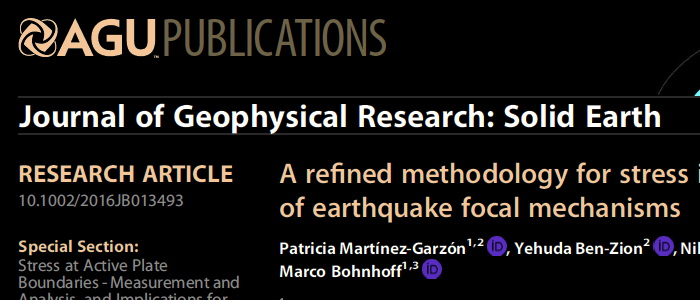Another article related to stress tensor inversion has been published in JGR! This one discusses the improved methodology for stress tensor inversion.
Reference:
Martínez-Garzón, P., Y. Ben-Zion, N. Abofalthian, G. Kwiatek, and M. Bohnhoff (2016). A refined methodology for stress inversions of earthquake focal mechanisms. J. Geophys. Res., 121, 8666-8687, DOI: 10.1002/2016JB013493. [ Article Page ]
Abstract:
We develop an improved methodology for reliable high-resolution inversions of focal mechanisms to background stress field orientation and stress ratio R in two or three dimensions. The earthquake catalog is declustered to remove events likely affected strongly by local stress interactions rather than reflecting the large-scale background stress field. The declustered data are discretized with the k-means algorithm into groups containing a number of focal mechanisms between a minimum number Nmin and 2Nmin. Synthetic tests indicate that Nmin ≈ 30 provides stable inversion results under different stress regimes and noise conditions when R ≈ 0.5, while Nmin ≈ 45 is needed for R near 0 or 1. Additional synthetic tests compare the performance of selecting the fault plane of each focal mechanism using (a) the plane with lowest misfit angle between the slip vector from the focal mechanism and shear traction from the stress tensor and (b) the plane with highest instability coefficient representing proximity to the optimally oriented fault for given stress field and friction coefficient. The instability criterion is found to provide more accurate inversion results under all tested stress regimes, stress ratios, and noise conditions. The refined inversion methodology combines selecting fault planes using the instability criterion iteratively with a damped simultaneous inversion of different focal mechanism groups. Results characterizing neighborhoods of discretized domains merged during the damped inversion provide high-resolution information independent of the discretization. Some aspects of the methodology are illustrated with focal mechanism data from the San Jacinto Fault Zone in Southern California.
